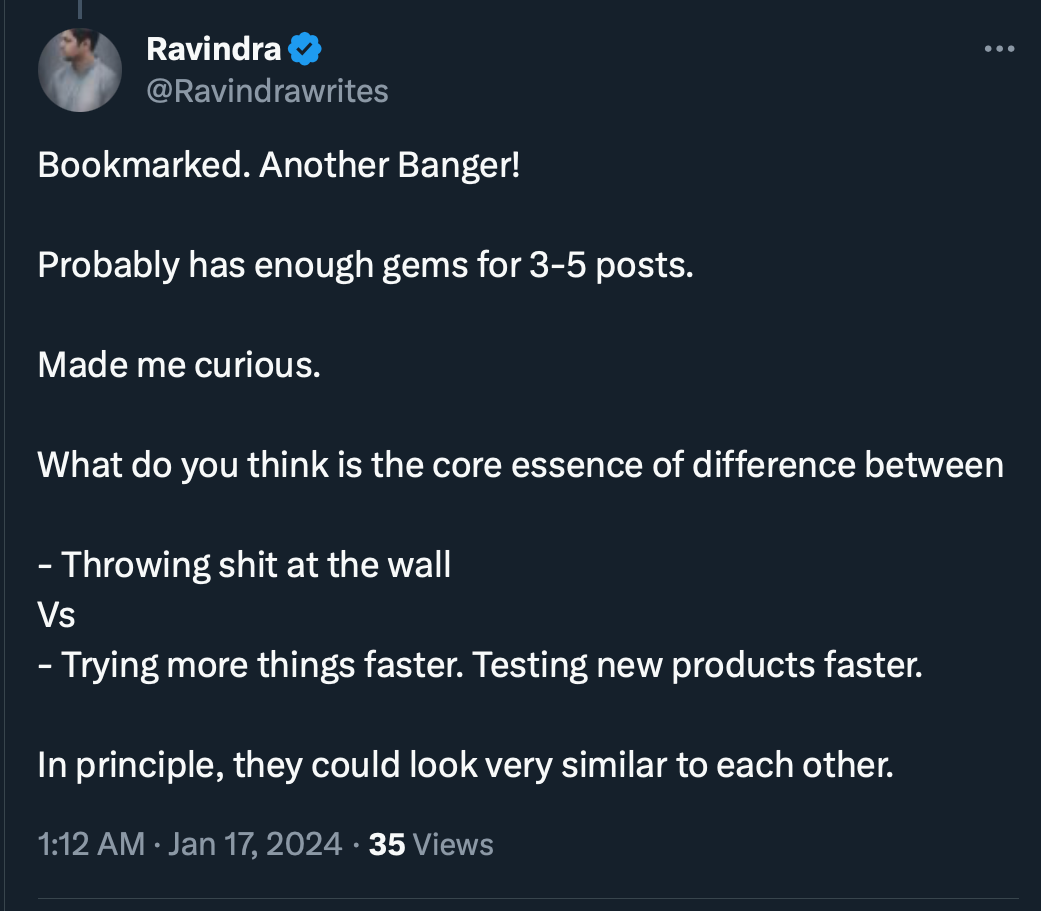What’s good young and eager mind?!
A few days ago I posted this:
Here's how I'd start a $100K/yr solopreneur business if I had to start over
What’s good young and eager mind! Since we’re still early in 2024, I thought, what better than to discuss what I’d do differently knowing what I know now when it comes to making a living as a solopreneur? Matcha on the left & Spotify on the right, so let’s get cracking.
Buddy of mine, Ravindra, asked the following questions:
If your advice is not to throw shit at the wall but to try more things faster, won’t they simply converge eventually?
Here’s my answer about the difference between the two methodologies:
Thanks for the kind words buddy!
Yeah, that's a really good question.
I think the difference is moving from continuous to discrete.
So instead of having some vague idea of what you wanna do and tinkering with it until you lose the will to live (which is basically the strategy of most solos), you wanna do smth like the "12 startups in 12 months."
That gives you concrete boundaries for your experiments.
Every month, you try to validate a new idea.
If it doesn't work, you move on to the next thing.
What I mean by throwing shit against the wall is the no-plan approach.
Zero strategy.
You just come up with an idea in isolation.
You talk yourself into it more and more.
You fall deeply in love with your idea & vision.
Then you try everything you can to make it work even when the market responds poorly.
It's the type of reasoning dogmatic people use. "I believe X until you disprove it." Where "disproving" is a forever-moving goalpost. E.g. flat-earth, white supremacy, modern feminism, etc.
See Russel’s Teapot
Type I error & Type II error
Hope this educational illustration doesn’t offend anyone. I’m one of those dinosaurs who believe men can’t get pregnant cuz they… you know… don’t have fucking wombs.
Throwing shit = Type I error optimization
You're okay with false positives. So you label your idea positive and it takes a herculean effort before you finally say "maybe this idea just sucks." (If ever.)
Try more faster = Type II error optimization
You're quick to label ideas as negative and accept that you're gonna get a ton of false negatives.
But as solopreneurs (and entrepreneurs in general) there are no consequences to giving up on an idea too soon.
However, there are HUGE consequences to sticking to a bad idea too long.
If you're a scientist and despite your very best efforts, you're unable to prove smth exists, you say "We thought this was a positive but it was a false positive." [1] [2] [3]
(Incorrectly rejected the null hypothesis.)
That's great cuz at least it lets you publish a paper and gets you prestige.
What do you get as an entrepreneur?
Nothing.
Even if you rigorously "disprove" smth can't work, the market dynamic might be totally different in 5 years leading to another founder succeeding with the very idea you said was impossible.
E.g. Webvan -> Instacart; MySpace -> Facebook; Pets.com -> Chewy; Altavista -> Google.
See yesterday’s point about complexity:
Why idiots are more successful than you
What’s good Young and Eager mind? You know what’s fascinating… How acceptable it is to talk about how dumb you are. I don’t read books. I can’t do math. I can barely add two numbers in my head. Not even talking… bragging! Being dumb isn’t just accepted, it’s almost admired.
Hope that gives you a better understanding of how to increase your odds of success.
Now go have fun & I’ll see you after the weekend.
RJY
Chop wood. Carry water.
Notes
[1] Ether theory in physics.
The Michelson-Morley experiment (1887), designed to detect the Earth's movement through the hypothesized '"ether," found no variation in the speed of light in different directions. That result contradicted the ether theory and paved the way for Einstein's theory of relativity, which posited the constancy of the speed of light in all reference frames.
[2] Phillips Curve in economics.
The Phillips Curve (1958) posited an inverse relationship between unemployment and inflation. It suggested that lower unemployment goes hand-in-hand with higher inflation, and vice versa. The data seemed to be true everywhere.
Policymakers and economists widely accepted the Phillips Curve, using it as a guide for economic policy to balance unemployment and inflation.
However, in the 1970s, many economies experienced "stagflation" - a situation where high inflation and high unemployment occurred simultaneously. This phenomenon contradicted the Phillips Curve, which indicated that such a scenario should be highly unlikely or impossible.
[3] First-mover advantage in the entrepreneurial sciences.
The first-mover advantage theory suggested that early entry would almost guarantee a dominant market position and long-term profitability. However, later studies and market examples showed that being a first mover also involves high risks and costs, often leading to fast-following competitors actually becoming the market leader. (Pretty much Apple's - under Cook - strategy.)









